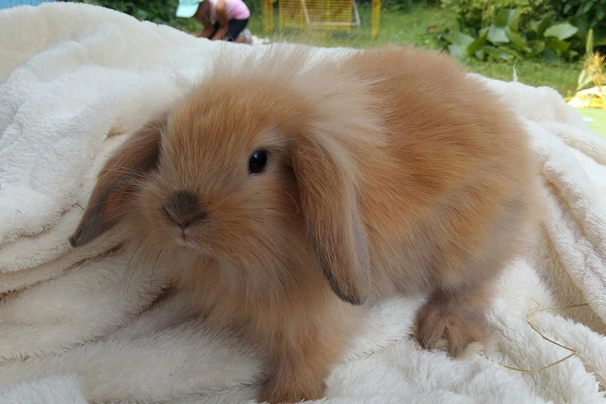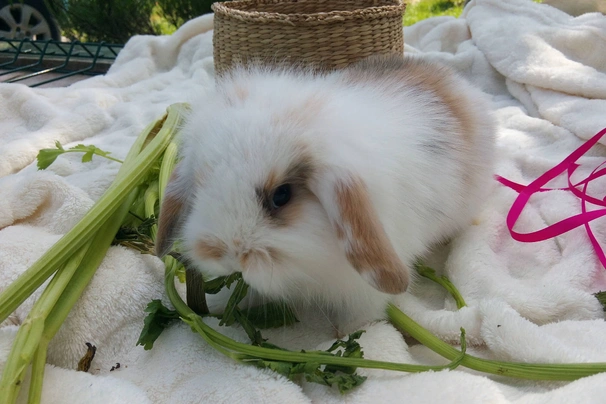Mini Lion Lop
Introduction of the Mini Lion Lop
This is a very new breed of rabbit, having been developed in the UK in the early 2000s and was only accepted by the British Rabbit Club is 2006. The Mini Lion Lop is a very small animal, typically weighing 3-4lbs.
The Mini Lion Lop shares many characteristics with the Mini Lop, but displays the very distinctive Lionhead mane and a hairier area on the chest. Currently the breed is championed by Jane Bramley in the UK, who worked tirelessly to achieve recognition for the Mini Lion Lop.
History of the Mini Lion Lop
The Mini Lion Lop was developed after breeders put a Lionhead Rabbit to one of the smaller Lop breeds. The Lionhead itself was developed in Europe following the appearance of a genetic mutation which lent a longer-haired breed the striking mane and bib the Lionhead breed is recognised for.
As the gene that gives the animal its distinctive Lionhead characteristics is dominant, breeding a pure-bred Lionhead with another rabbit will produce an animal with a mane and a bib.
The Mini Lion Lop has been produced by breeding the Lionhead with Mini Lops and Lionhead/Mini Lop hybrids. Lionheads have also been put to Dwarf Lops to create a Dwarf Lion Lop.
Appearance of the Mini Lion Lop
- Main colourways: black, agouti, white (with blue or red eyes), sooty, fawn, orange, butterfly, black otter, black fox, sable, smoke, beige, opal and steel
- Average weight: 1.5 – 1.6kg
A small rabbit, the Mini Lion Lop typically weighs around 3 – 3.5lbs with a robust ‘cobby’ build. The body is short and strong, with stocky back legs and well-rounded haunches. The head of the Mini Lion Lop is wide, with a curvy profile and the ears and wide and hang down the sides of the head.
The Lion Lop has lovely, soft medium length hair which culminates in a longer mane of fur encircling the head. This mane creates a ‘V’ behind the neck and falls over the head in between the ears.
A large number of colours are accepted by the British Rabbit Council including blacks, sables, orange, butterfly, steel, white, opal and agouti among others.
Temperament of the Mini Lion Lop
Although they are generally even tempered, friendly rabbits, Mini Lion Lops can be very lively. They are physically very active and thrive on lots of playtime and plenty of attention and company.
As long as he’d provided with plenty of opportunities to explore outdoors (a run or secure area of garden is a must!), lots of playtime with his owner – preferably with lots of cardboard tubes, boxes, and noisy cat toys, and perhaps a rabbit friend too; he’ll be a very happy bunny!
It’s also worth making sure you know how to pick up and hold your rabbit correctly. Rabbits can struggle and panic if they’re held incorrectly. They’re stronger than they look and can injure themselves or the handler if they feel uncomfortable or unsafe.
As the breed is still very much under development the temperament of the Mini Lion Lop can vary depending on the lines and the breeds used to develop them.
Health of the Mini Lion Lop
Like all rabbits, the Mini Lion Lop can develop dental problems, but this breed is actually prone to dental disease. The teeth should be checked regularly for signs of overgrowth and his diet should include fibrous vegetables that will help keep his teeth worn down. Enamel spurs and overgrown molars can prevent him from eating properly and can cause injuries in the mouth so it’s vital that the teeth are kept in good order.
As well as being planned to help keep his teeth worn down, his diet should be managed to avoid letting your rabbit get overweight. An overweight bunny can find it difficult to groom, and if his fur is allowed to become soiled with urine or faeces it can attract flies. These flies can lay eggs in the fur and the maggots could burrow into the rabbit’s flesh, causing painful open wounds that will require veterinary attention.
All rabbits should be vaccinated against Viral Haemorrhagic Disease and myxomatosis and should also be treated regularly for fleas, ticks and worms. It’s also worth considering spaying any non-breeding females in order to prevent uterine cancer, which is common in rabbits.
Caring for the Mini Lion Lop
Before you bring your rabbit home you must decide where he’s going to live. Is he going to be a house rabbit or will he have a hutch outdoors?
If your rabbit is going to live outdoors his hutch must be large enough for him to hope around and stand on his hind legs. It should be completely weather and waterproof and positioned out of direct sun and wind. The hutch should have shavings and straw on the floor and should also provide a covered area where the rabbit can nest. The hutch must be cleaned out completely once a week and droppings must be taken out every day.
Regardless of whether he’s going to live indoors or out he should have regular access to the outdoors, except in the very worst weather. A run or secure area of garden will allow him the opportunity to stretch his legs and indulge his love of exploration.
If he’s going to be a house rabbit he must be taught how to use a litter tray and be provided with an area he can retire to relax completely. A dog crate or indoor cage is ideal. Wires and cables should be kept out of the way and care should always be taken not to step on the rabbit.
His diet should include good quality hay, rabbit pellets and lost of fibrous green leaves and vegetables like kale, cabbage, carrot tops and dandelions and he should always have access to fresh, clean drinking water.

2 Male Mini Lion Lop Brothers & hutch
£160
Lovely mini lion lop baby bunnies
£90


